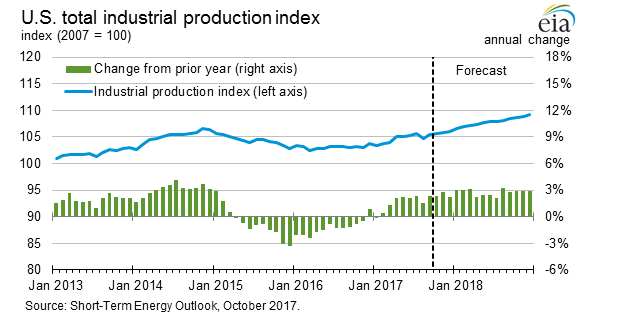
U.S. INDUSTRIAL PRODUCTION UP 0.3%

FRB - Industrial production rose 0.3 percent in September. The rates of change for July and August were notably revised; the current estimate for July, a decrease of 0.1 percent, was 0.5 percentage point lower than previously reported, while the estimate for August, a decrease of 0.7 percent, was 0.2 percentage point higher than before. The estimates for manufacturing, mining, and utilities were each revised lower in July. The continued effects of Hurricane Harvey and, to a lesser degree, the effects of Hurricane Irma combined to hold down the growth in total production in September by 1/4 percentage point. For the third quarter as a whole, industrial production fell 1.5 percent at an annual rate; excluding the effects of the hurricanes, the index would have risen at least 1/2 percent. Manufacturing output edged up 0.1 percent in September but fell 2.2 percent at an annual rate in the third quarter. The indexes for mining and utilities in September rose 0.4 percent and 1.5 percent, respectively. At 104.6 percent of its 2012 average, total industrial production in September was 1.6 percent above its year-earlier level. Capacity utilization for the industrial sector increased 0.2 percentage point in September to 76.0 percent, a rate that is 3.9 percentage points below its long-run (1972–2016) average.
Market Groups
The output of consumer goods moved up 0.5 percent in September, with gains for both durables and nondurables. The only major components of consumer goods to post losses were clothing, paper products, and consumer energy products. The output of business equipment rose 0.8 percent, as a decline of about 1 percent in transit equipment was outweighed by an increase in the industrial and other equipment category. Construction supplies and business supplies recorded gains of 1.9 percent and 0.6 percent, respectively. The production of materials declined 0.2 percent, a change that was more than accounted for by a drop of 7.2 percent in the index for chemical materials. The output of the chemical industry continued to be held down in the aftermath of Hurricane Harvey.
Industry Groups
Manufacturing output edged up 0.1 percent in September. A gain of 1.0 percent for durables outweighed a decrease of 0.9 percent for nondurables, and the output of other manufacturing (publishing and logging) was unchanged. Among durables, the largest increases—about 3 percent—were recorded by nonmetallic mineral products; machinery; and electrical equipment, appliances, and components. Among nondurables goods industries, declines were widespread, with the largest drop coming in the output of chemicals. Only the indexes for food, beverage, and tobacco products and for plastics and rubber products advanced.
In September, the rise of 0.4 percent for mining reflected a gain in oil and gas extraction; all of its other major components recorded losses. Over the past 12 months, mining output has increased 9.8 percent from its trough in September 2016.
Capacity utilization for manufacturing was unchanged at 75.1 percent in September, a rate that is 3.3 percentage points below its long-run average. Utilization for durables increased 0.7 percentage point to 74.9 percent, while the operating rate for nondurables fell 0.7 percentage point to 76.3 percent. The operating rate for mining edged up 0.1 percentage point to 83.5 percent, and the rate for utilities rose 1.1 percentage points to 74.8 percent.
-----
Earlier:

2017, October, 16, 11:55:00
U.S. ECONOMY UPEconomic activity in the United States has been growing moderately so far this year, and the labor market has continued to strengthen. The terrible hurricanes that hit Texas, Florida, Puerto Rico, and our neighbors in the Caribbean caused tremendous damage and upended many lives, and our hearts go out to those affected. While the effects of the hurricanes on the U.S. economy are quite noticeable in the short term, history suggests that the longer-term effects will be modest and that aggregate economic activity will recover quickly. |

2017, October, 16, 11:30:00
U.S. RIGS DOWN 8 TO 928U.S. Rig Count is up 389 rigs from last year's count of 539, with oil rigs up 311, gas rigs up 80, and miscellaneous rigs down 2 to 2. Canada Rig Count is up 47 rigs from last year's count of 165, with oil rigs up 22 and gas rigs up 25.
|

2017, October, 11, 12:45:00
U.S. OIL WELLS UP 84%API announced that estimated wells completed in the third quarter of 2017 increased 63 percent compared to the third quarter of 2016. This includes a dramatic 84 percent increase for all oil wells completed from year-ago levels.
|

2017, October, 6, 12:35:00
U.S. DEFICIT DOWN TO $42.4 BLNThe U.S. Census Bureau and the U.S. Bureau of Economic Analysis, through the Department of Commerce, announced today that the goods and services deficit was $42.4 billion in August, down $1.2 billion from $43.6 billion in July, revised. August exports were $195.3 billion, $0.8 billion more than July exports. August imports were $237.7 billion, $0.4 billion less than July imports.
|

2017, September, 29, 12:25:00
U.S. HIGHEST PELROLEUM DEMANDTotal petroleum deliveries in August moved up by 1.3 percent from August 2016 to average 20.5 million barrels per day. These were the highest August deliveries in 10 years, since 2007. Compared with July, total domestic petroleum deliveries, a measure of U.S. petroleum demand, decreased 0.6 percent. For year-to-date, total domestic petroleum deliveries moved up 1.3 percent compared to the same period last year.
|

2017, September, 29, 12:20:00
RUSSIA INFLUENCES U.S.“In light of Facebook’s disclosure of over $100,000 in social media advertising associated with Russian accounts focused on the disruption and influence of US politics through social media, it is likely that Russia undertook a similar effort using social media to influence the US energy market,”
|

2017, September, 29, 12:05:00
U.S. GDP UP 3.1%Real gross domestic product (GDP) increased at an annual rate of 3.1 percent in the second quarter of 2017 (table 1), according to the "third" estimate released by the Bureau of Economic Analysis. In the first quarter, real GDP increased 1.2 percent. |




